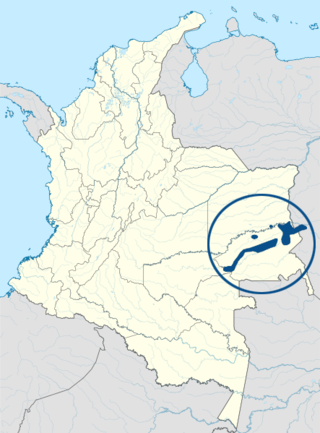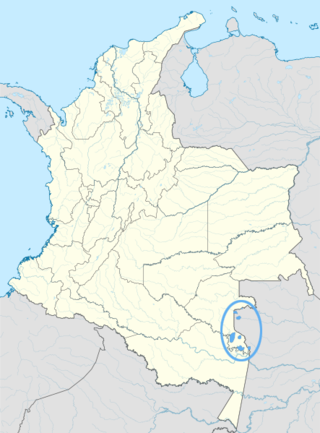Related Research Articles

The Pama–Nyungan languages are the most widespread family of Australian Aboriginal languages,containing 306 out of 400 Aboriginal languages in Australia. The name "Pama–Nyungan" is a merism:it is derived from the two end-points of the range,the Pama languages of northeast Australia and the Nyungan languages of southwest Australia.
Larry M. Hyman is Distinguished Professor Emeritus of Linguistics at the University of California,Berkeley. He specializes in phonology and has particular interest in African languages.

The Nadahup languages,also known as Makú (Macú) or Vaupés–Japurá,form a small language family in Brazil,Colombia,and Venezuela. The name Makú is pejorative,being derived from an Arawakan word meaning "without speech". Nadahup is an acronym of the constituent languages.
Marianne Mithun is an American linguist specializing in American Indian languages and language typology. She is a professor of linguistics at the University of California,Santa Barbara,where she has held an academic position since 1986.
Language documentation is a subfield of linguistics which aims to describe the grammar and use of human languages. It aims to provide a comprehensive record of the linguistic practices characteristic of a given speech community. Language documentation seeks to create as thorough a record as possible of the speech community for both posterity and language revitalization. This record can be public or private depending on the needs of the community and the purpose of the documentation. In practice,language documentation can range from solo linguistic anthropological fieldwork to the creation of vast online archives that contain dozens of different languages,such as FirstVoices or OLAC.

Macro-Pama-Nyungan is an umbrella term used to refer to a proposed Indigenous Australian language family. It was coined by the Australian linguist Nicholas Evans in his 1996 book Archaeology and linguistics:Aboriginal Australia in global perspective,co-authored by Patrick McConvell. The term arose from Evans' theory suggesting that two of the largest Indigenous Australian language families share a common origin,and should therefore be classified as a singular language family under "Macro-Pama-Nyungan".
The Archive of the Indigenous Languages of Latin America (AILLA) is a digital repository housed in LLILAS Benson Latin American Studies and Collections at the University of Texas at Austin. AILLA is a digital language archive dedicated to the digitization and preservation of primary data,such as field notes,texts,audio and video recordings,in or about Latin American indigenous languages. AILLA's holdings are available on the Internet and are open to the public wherever privacy and intellectual property concerns are met. AILLA has access portals in both English and Spanish;all metadata are available in both languages,as well as in indigenous languages where possible.

Puinave,Waipunavi (Guaipunabi) or Wanse is an indigenous language of Colombia and Venezuela. It is generally considered to be a language isolate.
Macro-Puinavean is a hypothetical proposal linking some very poorly attested languages to the Nadahup family. The Puinave language is sometimes linked specifically with the Nadahup languages and Nukak-Kakwa group,as Puinave–Maku. Paul Rivet (1920) and other researchers proposed decades ago the hypothesis of a Puinave-Makúfamily. Later,Joseph Greenberg (1987) grouped the Puinave-Makúlanguages,together with the Tucano family,the Katukinan,Waorani and Ticuna languages in the Macro-Tukano trunk.
Sandra Annear Thompson is an American linguist specializing in discourse analysis,typology,and interactional linguistics. She is Professor Emerita of Linguistics at the University of California,Santa Barbara (UCSB). She has published numerous books,her research has appeared in many linguistics journals,and she serves on the editorial board of several prominent linguistics journals.

The Hup language is one of the four Naduhup languages. It is spoken by the Hupda indigenous Amazonian peoples who live on the border between Colombia and the Brazilian state of Amazonas. There are approximately 1500 speakers of the Hup language. As of 2005,according to the linguist Epps,Hup is not seriously endangered –although the actual number of speakers is few,all Hupda children learn Hup as their first language.

Professor Anvita Abbi is an Indian linguist and scholar of minority languages,known for her studies on tribal languages and other minority languages of South Asia. In 2013,she was honoured with the Padma Shri,the fourth highest civilian award by the Government of India for her contributions to the field of linguistics.
Carol E. Genetti is an American linguist who is known for her research into Tibeto-Burman languages and languages of the Himalayans.
Claire Louise Bowern is a linguist who works with Australian Indigenous languages. She is currently a professor of linguistics at Yale University,and has a secondary appointment in the department of anthropology at Yale.
Juliette Blevins is an American linguist whose work has contributed to the fields of phonology,phonetics,historical linguistics,and typology. She is currently professor of linguistics at the Graduate Center,CUNY.
The Kenneth L. Hale Award,named after linguist Kenneth L. Hale,is an award given to a member of the Linguistic Society of America in order to recognize "scholars who have done outstanding work on the documentation of a particular language or family of languages that is endangered or no longer spoken." It has been described as one "response to the urgency of recording endangered languages before they disappear."
Kristine Hildebrandt is an American linguist who is known for her research into Tibeto-Burman languages and languages of the Himalayas. Her work focuses on the Nar-Phu and Gurung languages and other languages of the Manang District of Nepal,with an expertise in phonetics.

Azeb Amha is an Ethiopian linguist working on the morphology and syntax of Afroasiatic languages,with a special focus on Omotic languages. A senior researcher at the African Studies Center Leiden,Azeb is co-editor of the international Journal of African Languages and Linguistics and member of the board of the Dutch Society for African Studies (NVAS).
Ashwini Deo is a linguist who specializes in semantics,pragmatics,and language variation and change,with an empirical focus on the Indo-Aryan languages. She is currently Professor of Linguistics at the University of Texas at Austin.
Birgit Hellwig is a German linguist specializing in African and Papuan languages. She is professor of general linguistics at the University of Cologne.
References
- 1 2 "Patience L. Epps". University of Texas at Austin Linguistics Department Faculty Directory. Retrieved 8 March 2021.
- ↑ Virginia, Epps, Patience, Department of Anthropology, University of. "A grammar of Hup". libraetd.lib.virginia.edu. Retrieved 2022-03-13.
{{cite web}}: CS1 maint: multiple names: authors list (link) - 1 2 3 Epps, Patience, Patience Epps Curriculum Vitae (PDF), retrieved 8 March 2021
- ↑ Bowern, Claire; Epps, Patience; Hill, Jane H.; McConvell, Patrick. "Hunter-Gatherer Database" . Retrieved 8 March 2021.
- ↑ "CELP Roster 2021". Linguistic Society of America Committee on Endangered Languages and their Preservation. Retrieved 4 June 2022.
- ↑ Epps, Patience (2008). A Grammar of Hup. doi:10.1515/9783110199079. ISBN 9783110199079.
- ↑ "Pāṇini Award Recipients". Association for Linguistic Typology.
- ↑ "2020 Award Winners Announced: Early Career Award, Kenneth L. Hale Award, & Linguistics, Language, and the Public Award". Linguistic Society of America. Retrieved 8 March 2021.